49006 Risk Management: Comprehensive Engineering Risk Management Plan
VerifiedAdded on 2023/06/13
|23
|5968
|323
Report
AI Summary
This report presents a risk management plan, prepared in accordance with AS/NZS 31000:2009, for the Brisbane Quarter project, a mixed-use development in Brisbane, Australia. The plan outlines communication and consultation strategies, establishes the risk management context, and identifies potential health and safety risks associated with the project, such as airborne substances, water quality issues, and equipment hazards. Risk analysis is conducted using FMEA and risk matrix techniques, followed by risk evaluation using the ALARP principle. The report details risk treatment options and establishes a monitoring and review plan to ensure the effectiveness of implemented controls. The document is available on Desklib, a platform that provides AI-based study tools and solved assignments for students.

Risk Management Plan 1
RISK MANAGEMENT PLAN
BRISBANE QUARTER PROJECT
Name
Course
Professor
University
City/state
Date
RISK MANAGEMENT PLAN
BRISBANE QUARTER PROJECT
Name
Course
Professor
University
City/state
Date
Paraphrase This Document
Need a fresh take? Get an instant paraphrase of this document with our AI Paraphraser
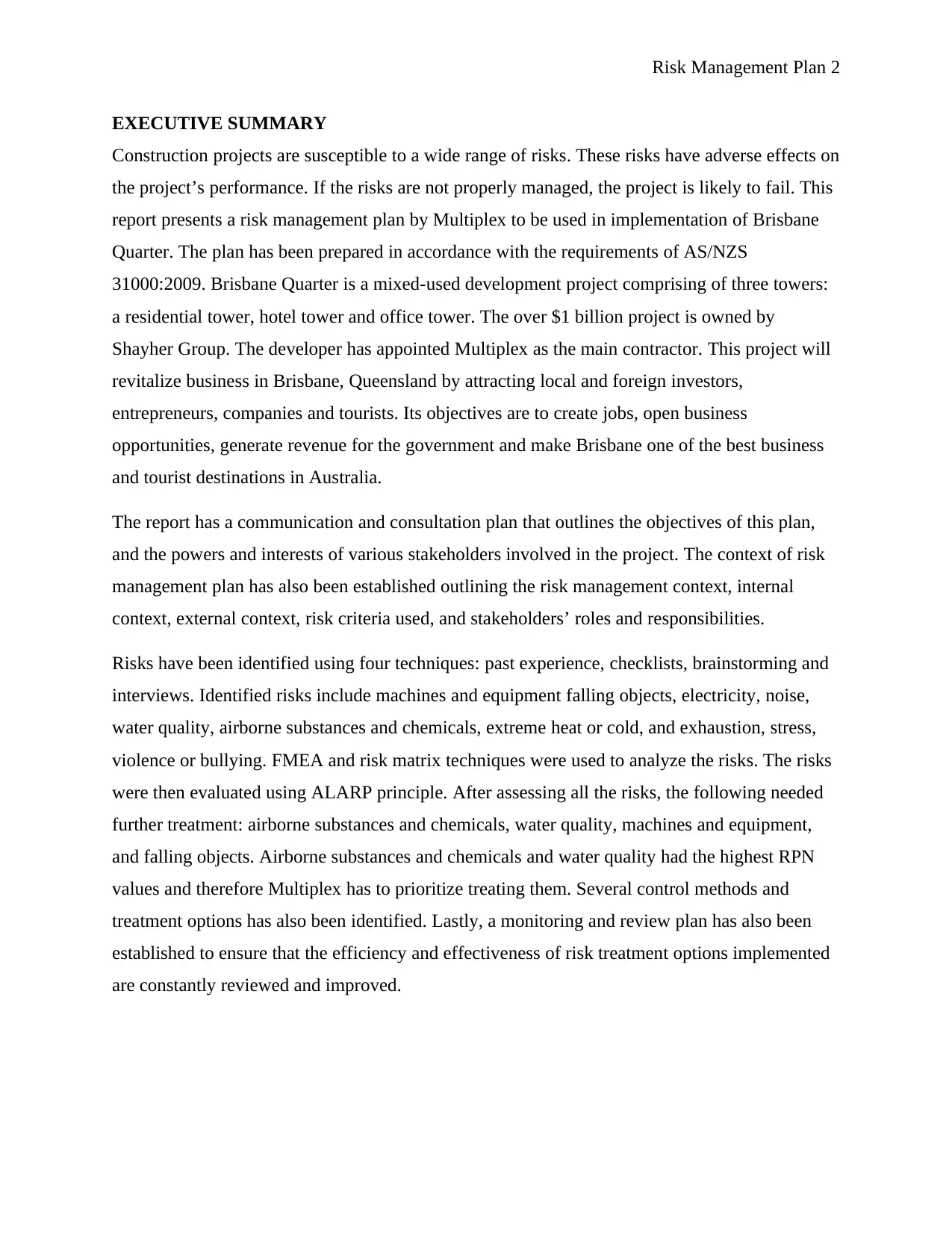
Risk Management Plan 2
EXECUTIVE SUMMARY
Construction projects are susceptible to a wide range of risks. These risks have adverse effects on
the project’s performance. If the risks are not properly managed, the project is likely to fail. This
report presents a risk management plan by Multiplex to be used in implementation of Brisbane
Quarter. The plan has been prepared in accordance with the requirements of AS/NZS
31000:2009. Brisbane Quarter is a mixed-used development project comprising of three towers:
a residential tower, hotel tower and office tower. The over $1 billion project is owned by
Shayher Group. The developer has appointed Multiplex as the main contractor. This project will
revitalize business in Brisbane, Queensland by attracting local and foreign investors,
entrepreneurs, companies and tourists. Its objectives are to create jobs, open business
opportunities, generate revenue for the government and make Brisbane one of the best business
and tourist destinations in Australia.
The report has a communication and consultation plan that outlines the objectives of this plan,
and the powers and interests of various stakeholders involved in the project. The context of risk
management plan has also been established outlining the risk management context, internal
context, external context, risk criteria used, and stakeholders’ roles and responsibilities.
Risks have been identified using four techniques: past experience, checklists, brainstorming and
interviews. Identified risks include machines and equipment falling objects, electricity, noise,
water quality, airborne substances and chemicals, extreme heat or cold, and exhaustion, stress,
violence or bullying. FMEA and risk matrix techniques were used to analyze the risks. The risks
were then evaluated using ALARP principle. After assessing all the risks, the following needed
further treatment: airborne substances and chemicals, water quality, machines and equipment,
and falling objects. Airborne substances and chemicals and water quality had the highest RPN
values and therefore Multiplex has to prioritize treating them. Several control methods and
treatment options has also been identified. Lastly, a monitoring and review plan has also been
established to ensure that the efficiency and effectiveness of risk treatment options implemented
are constantly reviewed and improved.
EXECUTIVE SUMMARY
Construction projects are susceptible to a wide range of risks. These risks have adverse effects on
the project’s performance. If the risks are not properly managed, the project is likely to fail. This
report presents a risk management plan by Multiplex to be used in implementation of Brisbane
Quarter. The plan has been prepared in accordance with the requirements of AS/NZS
31000:2009. Brisbane Quarter is a mixed-used development project comprising of three towers:
a residential tower, hotel tower and office tower. The over $1 billion project is owned by
Shayher Group. The developer has appointed Multiplex as the main contractor. This project will
revitalize business in Brisbane, Queensland by attracting local and foreign investors,
entrepreneurs, companies and tourists. Its objectives are to create jobs, open business
opportunities, generate revenue for the government and make Brisbane one of the best business
and tourist destinations in Australia.
The report has a communication and consultation plan that outlines the objectives of this plan,
and the powers and interests of various stakeholders involved in the project. The context of risk
management plan has also been established outlining the risk management context, internal
context, external context, risk criteria used, and stakeholders’ roles and responsibilities.
Risks have been identified using four techniques: past experience, checklists, brainstorming and
interviews. Identified risks include machines and equipment falling objects, electricity, noise,
water quality, airborne substances and chemicals, extreme heat or cold, and exhaustion, stress,
violence or bullying. FMEA and risk matrix techniques were used to analyze the risks. The risks
were then evaluated using ALARP principle. After assessing all the risks, the following needed
further treatment: airborne substances and chemicals, water quality, machines and equipment,
and falling objects. Airborne substances and chemicals and water quality had the highest RPN
values and therefore Multiplex has to prioritize treating them. Several control methods and
treatment options has also been identified. Lastly, a monitoring and review plan has also been
established to ensure that the efficiency and effectiveness of risk treatment options implemented
are constantly reviewed and improved.

Risk Management Plan 3
Table of Contents
EXECUTIVE SUMMARY.......................................................................................................................2
1. INTRODUCTION.............................................................................................................................4
1.1. General.......................................................................................................................................4
1.2. Project Details, Scope and Objectives......................................................................................4
1.3. Risk Management Process........................................................................................................6
2. COMMUNICATION AND CONSULTATION..............................................................................7
2.1. Objectives...................................................................................................................................7
2.2. Stakeholders Power/Interests....................................................................................................7
3. ESTABLISHING THE CONTEXT.................................................................................................8
3.1. General.......................................................................................................................................8
3.2. Risk Management Context........................................................................................................9
3.3. Internal Context.........................................................................................................................9
3.4. External Context........................................................................................................................9
3.5. Defining Risk Criteria.............................................................................................................10
3.6. Stakeholders.............................................................................................................................10
3.6.1. Internal and external stakeholders......................................................................................10
3.6.2. Roles and Responsibilities.................................................................................................11
4. RISK ASSESSMENT......................................................................................................................12
4.1. Risk Identification...................................................................................................................12
4.2. Risk Analysis............................................................................................................................13
4.2.1. Method of risk analysis......................................................................................................13
4.2.2. Exiting risk controls...........................................................................................................14
4.2.3. Risk acceptance criteria.....................................................................................................14
4.3. Risk Evaluation........................................................................................................................14
5. RISK TREATMENT.......................................................................................................................15
6. MONITORING AND REVIEW.....................................................................................................16
References................................................................................................................................................18
APPENDICES.........................................................................................................................................21
Appendix 1: Risk Register.....................................................................................................................21
Appendix 2: FMEA analysis (severity, occurrence and detectability are rated on a 1 to 10 scale)........22
Table of Contents
EXECUTIVE SUMMARY.......................................................................................................................2
1. INTRODUCTION.............................................................................................................................4
1.1. General.......................................................................................................................................4
1.2. Project Details, Scope and Objectives......................................................................................4
1.3. Risk Management Process........................................................................................................6
2. COMMUNICATION AND CONSULTATION..............................................................................7
2.1. Objectives...................................................................................................................................7
2.2. Stakeholders Power/Interests....................................................................................................7
3. ESTABLISHING THE CONTEXT.................................................................................................8
3.1. General.......................................................................................................................................8
3.2. Risk Management Context........................................................................................................9
3.3. Internal Context.........................................................................................................................9
3.4. External Context........................................................................................................................9
3.5. Defining Risk Criteria.............................................................................................................10
3.6. Stakeholders.............................................................................................................................10
3.6.1. Internal and external stakeholders......................................................................................10
3.6.2. Roles and Responsibilities.................................................................................................11
4. RISK ASSESSMENT......................................................................................................................12
4.1. Risk Identification...................................................................................................................12
4.2. Risk Analysis............................................................................................................................13
4.2.1. Method of risk analysis......................................................................................................13
4.2.2. Exiting risk controls...........................................................................................................14
4.2.3. Risk acceptance criteria.....................................................................................................14
4.3. Risk Evaluation........................................................................................................................14
5. RISK TREATMENT.......................................................................................................................15
6. MONITORING AND REVIEW.....................................................................................................16
References................................................................................................................................................18
APPENDICES.........................................................................................................................................21
Appendix 1: Risk Register.....................................................................................................................21
Appendix 2: FMEA analysis (severity, occurrence and detectability are rated on a 1 to 10 scale)........22
⊘ This is a preview!⊘
Do you want full access?
Subscribe today to unlock all pages.

Trusted by 1+ million students worldwide
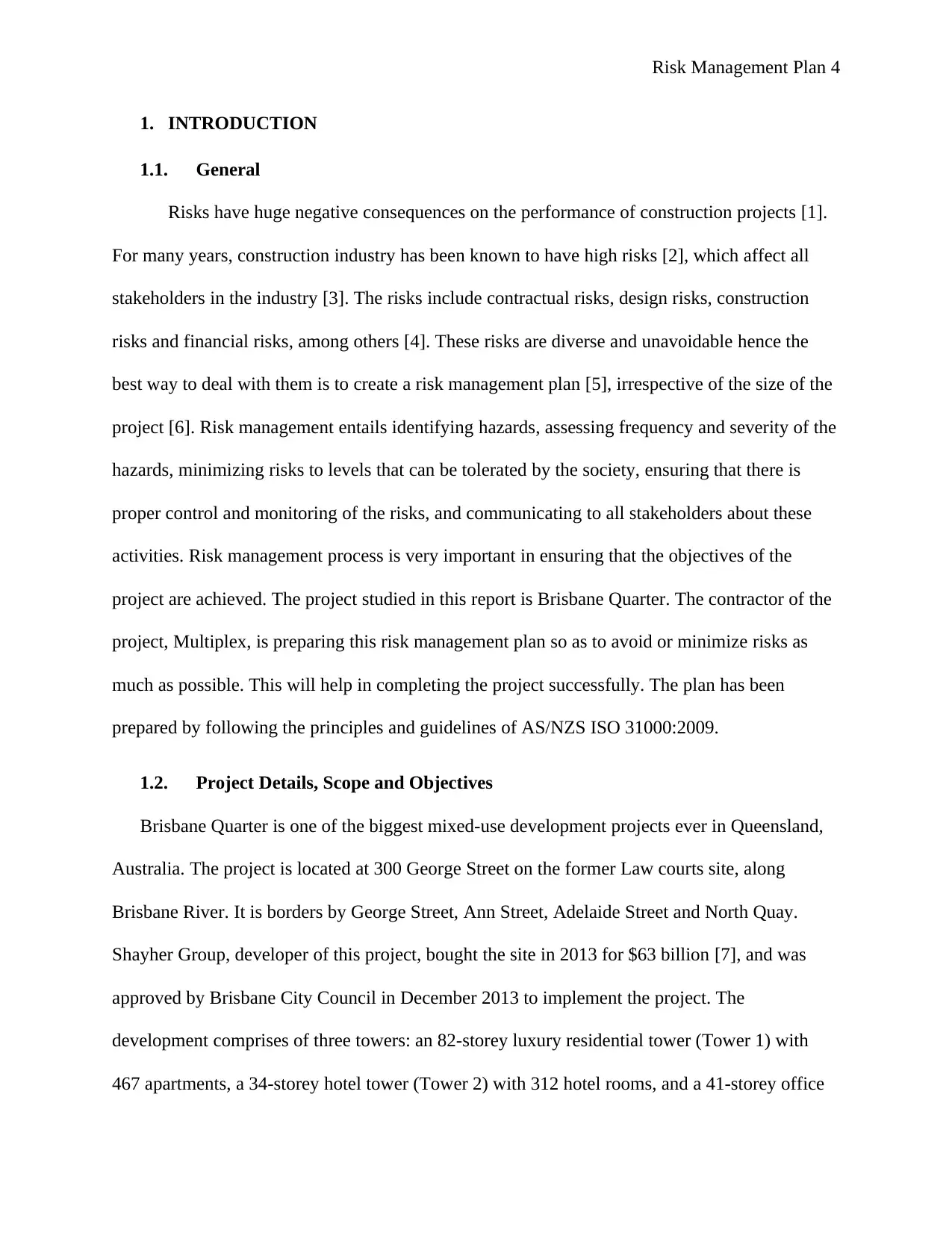
Risk Management Plan 4
1. INTRODUCTION
1.1. General
Risks have huge negative consequences on the performance of construction projects [1].
For many years, construction industry has been known to have high risks [2], which affect all
stakeholders in the industry [3]. The risks include contractual risks, design risks, construction
risks and financial risks, among others [4]. These risks are diverse and unavoidable hence the
best way to deal with them is to create a risk management plan [5], irrespective of the size of the
project [6]. Risk management entails identifying hazards, assessing frequency and severity of the
hazards, minimizing risks to levels that can be tolerated by the society, ensuring that there is
proper control and monitoring of the risks, and communicating to all stakeholders about these
activities. Risk management process is very important in ensuring that the objectives of the
project are achieved. The project studied in this report is Brisbane Quarter. The contractor of the
project, Multiplex, is preparing this risk management plan so as to avoid or minimize risks as
much as possible. This will help in completing the project successfully. The plan has been
prepared by following the principles and guidelines of AS/NZS ISO 31000:2009.
1.2. Project Details, Scope and Objectives
Brisbane Quarter is one of the biggest mixed-use development projects ever in Queensland,
Australia. The project is located at 300 George Street on the former Law courts site, along
Brisbane River. It is borders by George Street, Ann Street, Adelaide Street and North Quay.
Shayher Group, developer of this project, bought the site in 2013 for $63 billion [7], and was
approved by Brisbane City Council in December 2013 to implement the project. The
development comprises of three towers: an 82-storey luxury residential tower (Tower 1) with
467 apartments, a 34-storey hotel tower (Tower 2) with 312 hotel rooms, and a 41-storey office
1. INTRODUCTION
1.1. General
Risks have huge negative consequences on the performance of construction projects [1].
For many years, construction industry has been known to have high risks [2], which affect all
stakeholders in the industry [3]. The risks include contractual risks, design risks, construction
risks and financial risks, among others [4]. These risks are diverse and unavoidable hence the
best way to deal with them is to create a risk management plan [5], irrespective of the size of the
project [6]. Risk management entails identifying hazards, assessing frequency and severity of the
hazards, minimizing risks to levels that can be tolerated by the society, ensuring that there is
proper control and monitoring of the risks, and communicating to all stakeholders about these
activities. Risk management process is very important in ensuring that the objectives of the
project are achieved. The project studied in this report is Brisbane Quarter. The contractor of the
project, Multiplex, is preparing this risk management plan so as to avoid or minimize risks as
much as possible. This will help in completing the project successfully. The plan has been
prepared by following the principles and guidelines of AS/NZS ISO 31000:2009.
1.2. Project Details, Scope and Objectives
Brisbane Quarter is one of the biggest mixed-use development projects ever in Queensland,
Australia. The project is located at 300 George Street on the former Law courts site, along
Brisbane River. It is borders by George Street, Ann Street, Adelaide Street and North Quay.
Shayher Group, developer of this project, bought the site in 2013 for $63 billion [7], and was
approved by Brisbane City Council in December 2013 to implement the project. The
development comprises of three towers: an 82-storey luxury residential tower (Tower 1) with
467 apartments, a 34-storey hotel tower (Tower 2) with 312 hotel rooms, and a 41-storey office
Paraphrase This Document
Need a fresh take? Get an instant paraphrase of this document with our AI Paraphraser
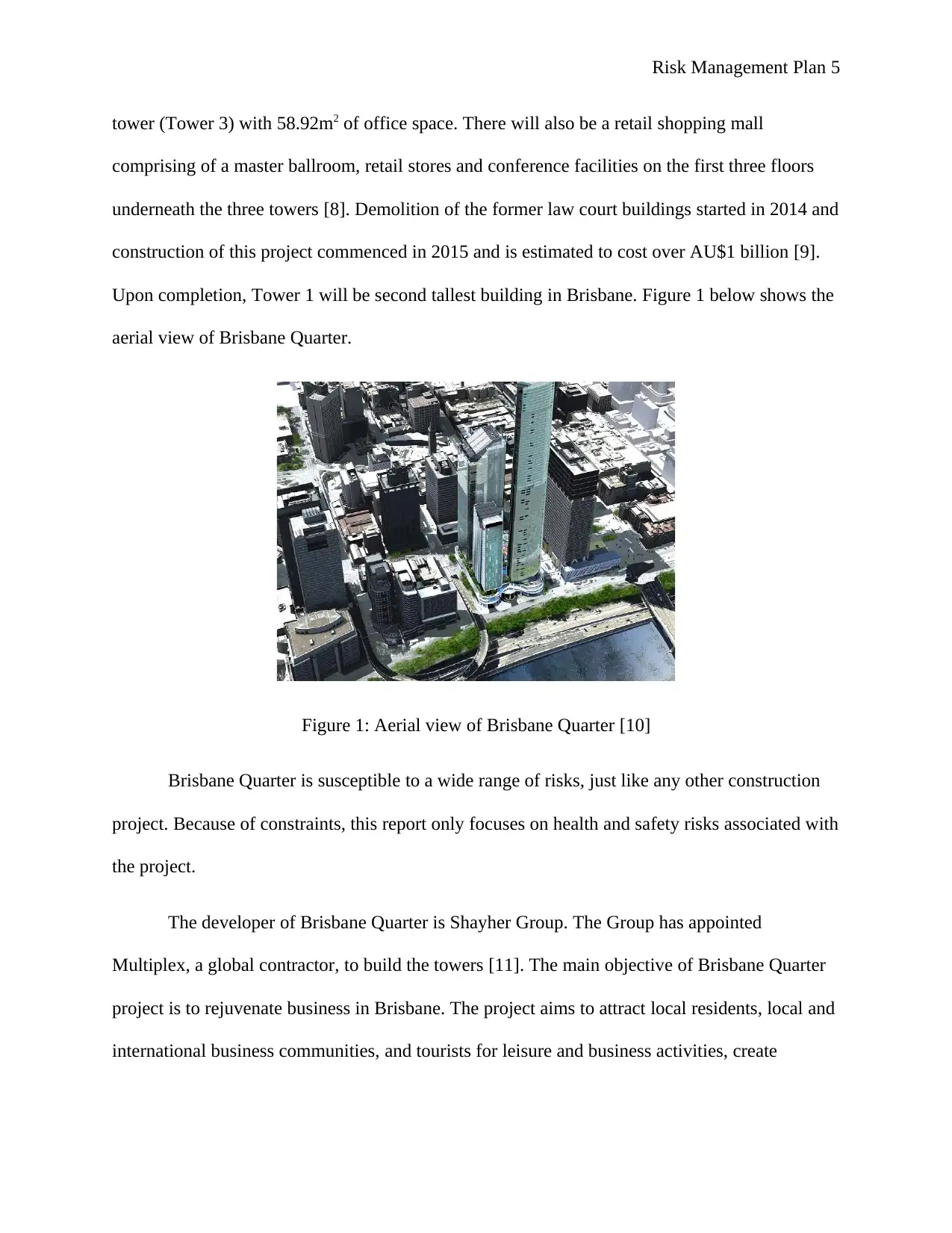
Risk Management Plan 5
tower (Tower 3) with 58.92m2 of office space. There will also be a retail shopping mall
comprising of a master ballroom, retail stores and conference facilities on the first three floors
underneath the three towers [8]. Demolition of the former law court buildings started in 2014 and
construction of this project commenced in 2015 and is estimated to cost over AU$1 billion [9].
Upon completion, Tower 1 will be second tallest building in Brisbane. Figure 1 below shows the
aerial view of Brisbane Quarter.
Figure 1: Aerial view of Brisbane Quarter [10]
Brisbane Quarter is susceptible to a wide range of risks, just like any other construction
project. Because of constraints, this report only focuses on health and safety risks associated with
the project.
The developer of Brisbane Quarter is Shayher Group. The Group has appointed
Multiplex, a global contractor, to build the towers [11]. The main objective of Brisbane Quarter
project is to rejuvenate business in Brisbane. The project aims to attract local residents, local and
international business communities, and tourists for leisure and business activities, create
tower (Tower 3) with 58.92m2 of office space. There will also be a retail shopping mall
comprising of a master ballroom, retail stores and conference facilities on the first three floors
underneath the three towers [8]. Demolition of the former law court buildings started in 2014 and
construction of this project commenced in 2015 and is estimated to cost over AU$1 billion [9].
Upon completion, Tower 1 will be second tallest building in Brisbane. Figure 1 below shows the
aerial view of Brisbane Quarter.
Figure 1: Aerial view of Brisbane Quarter [10]
Brisbane Quarter is susceptible to a wide range of risks, just like any other construction
project. Because of constraints, this report only focuses on health and safety risks associated with
the project.
The developer of Brisbane Quarter is Shayher Group. The Group has appointed
Multiplex, a global contractor, to build the towers [11]. The main objective of Brisbane Quarter
project is to rejuvenate business in Brisbane. The project aims to attract local residents, local and
international business communities, and tourists for leisure and business activities, create
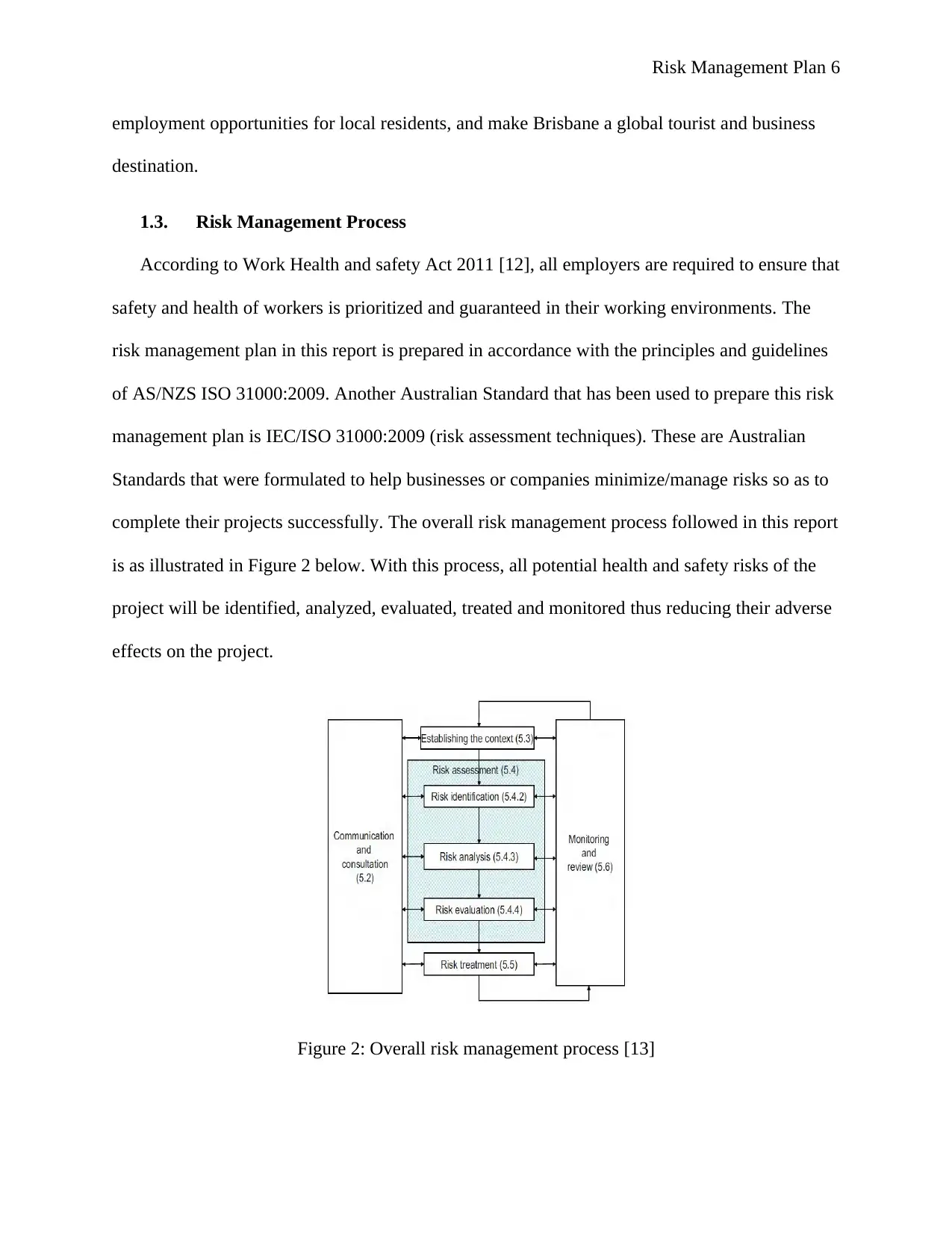
Risk Management Plan 6
employment opportunities for local residents, and make Brisbane a global tourist and business
destination.
1.3. Risk Management Process
According to Work Health and safety Act 2011 [12], all employers are required to ensure that
safety and health of workers is prioritized and guaranteed in their working environments. The
risk management plan in this report is prepared in accordance with the principles and guidelines
of AS/NZS ISO 31000:2009. Another Australian Standard that has been used to prepare this risk
management plan is IEC/ISO 31000:2009 (risk assessment techniques). These are Australian
Standards that were formulated to help businesses or companies minimize/manage risks so as to
complete their projects successfully. The overall risk management process followed in this report
is as illustrated in Figure 2 below. With this process, all potential health and safety risks of the
project will be identified, analyzed, evaluated, treated and monitored thus reducing their adverse
effects on the project.
Figure 2: Overall risk management process [13]
employment opportunities for local residents, and make Brisbane a global tourist and business
destination.
1.3. Risk Management Process
According to Work Health and safety Act 2011 [12], all employers are required to ensure that
safety and health of workers is prioritized and guaranteed in their working environments. The
risk management plan in this report is prepared in accordance with the principles and guidelines
of AS/NZS ISO 31000:2009. Another Australian Standard that has been used to prepare this risk
management plan is IEC/ISO 31000:2009 (risk assessment techniques). These are Australian
Standards that were formulated to help businesses or companies minimize/manage risks so as to
complete their projects successfully. The overall risk management process followed in this report
is as illustrated in Figure 2 below. With this process, all potential health and safety risks of the
project will be identified, analyzed, evaluated, treated and monitored thus reducing their adverse
effects on the project.
Figure 2: Overall risk management process [13]
⊘ This is a preview!⊘
Do you want full access?
Subscribe today to unlock all pages.

Trusted by 1+ million students worldwide

Risk Management Plan 7
2. COMMUNICATION AND CONSULTATION
Communication and consultation are very important in successful implementation of any
engineering project. Through communication and consultation, stakeholders share knowledge,
experiences and challenges. It also improves collaboration between stakeholders thus minimizing
conflicts and disputes [14]. It is also through effective communication that stakeholders get to
understand their roles and responsibilities, and seek help when necessary [14]. Based on the
experience that Multiplex has in construction industry, the company will have a comprehensive
communication and consultation plan to ensure that all stakeholders involved in the project are
fully informed on every activity.
2.1. Objectives
The objectives of communication and consultation plan are: share information with all
stakeholders about components, benefits and implementation of risk management plan; educate
stakeholders about risks and their harms; give stakeholders an opportunity to provide their
opinions on how risks should be minimized/managed; get to know the interests of each
stakeholder; enhance coordination and collaboration among stakeholders; help stakeholders
understand their responsibilities and the consequences of failing to accomplish them; share
challenges that stakeholders are experiencing; ensure that stakeholders are updated with the
progress of the project; and encourage stakeholders to have common goals and work together to
achieve them.
2.2. Stakeholders Power/Interests
For risks to be managed properly, the goals and interests of stakeholders must be understood
[15]. This helps in ensuring that stakeholders are allocated roles and responsibilities which they
are able to execute effectively and help implement risk management plan. This project involves
2. COMMUNICATION AND CONSULTATION
Communication and consultation are very important in successful implementation of any
engineering project. Through communication and consultation, stakeholders share knowledge,
experiences and challenges. It also improves collaboration between stakeholders thus minimizing
conflicts and disputes [14]. It is also through effective communication that stakeholders get to
understand their roles and responsibilities, and seek help when necessary [14]. Based on the
experience that Multiplex has in construction industry, the company will have a comprehensive
communication and consultation plan to ensure that all stakeholders involved in the project are
fully informed on every activity.
2.1. Objectives
The objectives of communication and consultation plan are: share information with all
stakeholders about components, benefits and implementation of risk management plan; educate
stakeholders about risks and their harms; give stakeholders an opportunity to provide their
opinions on how risks should be minimized/managed; get to know the interests of each
stakeholder; enhance coordination and collaboration among stakeholders; help stakeholders
understand their responsibilities and the consequences of failing to accomplish them; share
challenges that stakeholders are experiencing; ensure that stakeholders are updated with the
progress of the project; and encourage stakeholders to have common goals and work together to
achieve them.
2.2. Stakeholders Power/Interests
For risks to be managed properly, the goals and interests of stakeholders must be understood
[15]. This helps in ensuring that stakeholders are allocated roles and responsibilities which they
are able to execute effectively and help implement risk management plan. This project involves
Paraphrase This Document
Need a fresh take? Get an instant paraphrase of this document with our AI Paraphraser
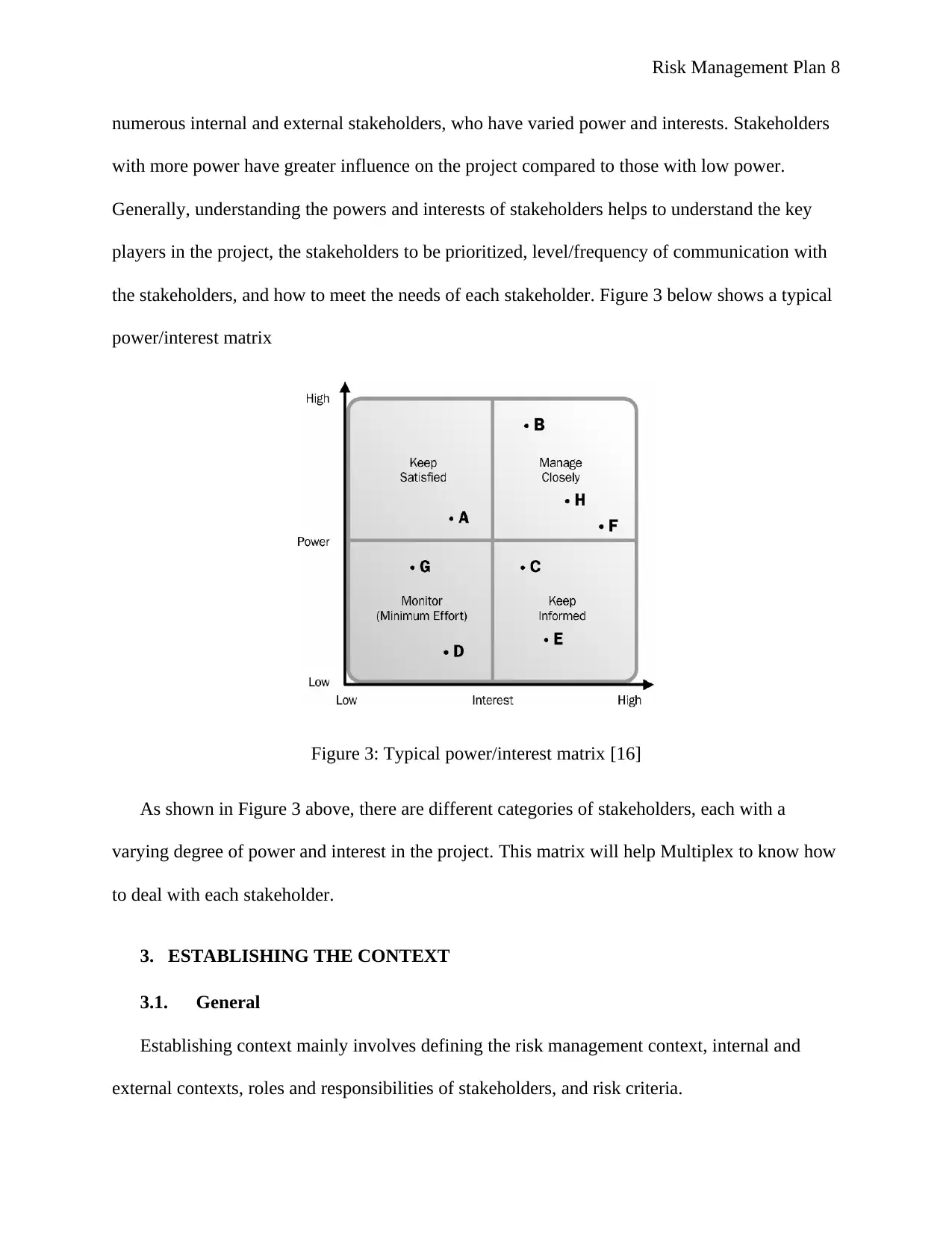
Risk Management Plan 8
numerous internal and external stakeholders, who have varied power and interests. Stakeholders
with more power have greater influence on the project compared to those with low power.
Generally, understanding the powers and interests of stakeholders helps to understand the key
players in the project, the stakeholders to be prioritized, level/frequency of communication with
the stakeholders, and how to meet the needs of each stakeholder. Figure 3 below shows a typical
power/interest matrix
Figure 3: Typical power/interest matrix [16]
As shown in Figure 3 above, there are different categories of stakeholders, each with a
varying degree of power and interest in the project. This matrix will help Multiplex to know how
to deal with each stakeholder.
3. ESTABLISHING THE CONTEXT
3.1. General
Establishing context mainly involves defining the risk management context, internal and
external contexts, roles and responsibilities of stakeholders, and risk criteria.
numerous internal and external stakeholders, who have varied power and interests. Stakeholders
with more power have greater influence on the project compared to those with low power.
Generally, understanding the powers and interests of stakeholders helps to understand the key
players in the project, the stakeholders to be prioritized, level/frequency of communication with
the stakeholders, and how to meet the needs of each stakeholder. Figure 3 below shows a typical
power/interest matrix
Figure 3: Typical power/interest matrix [16]
As shown in Figure 3 above, there are different categories of stakeholders, each with a
varying degree of power and interest in the project. This matrix will help Multiplex to know how
to deal with each stakeholder.
3. ESTABLISHING THE CONTEXT
3.1. General
Establishing context mainly involves defining the risk management context, internal and
external contexts, roles and responsibilities of stakeholders, and risk criteria.

Risk Management Plan 9
3.2. Risk Management Context
This risk management plan only focuses on health and safety issue related to Brisbane
Quarter. The plan will only be used to mitigate health and safety risks to the workers, public and
the environment. This is important because workers, public and the environment are highly
susceptible to health and safety issues in this kind of projects [18]. Therefore, their health and
safety should always come first [19]. The project is located along Brisbane River thus posing
risks to the water quality of the river, aquatic life and residents and businesses that depend on the
river. It also involves use of different materials, equipment, plant and machines, which pose
various health and safety risks to workers. So the risk management plan will establish the best
ways of managing these health and safety risks, such as training of workers [20].
3.3. Internal Context
Multiplex is a Sydney-based leading global contractor that has vast experience in
development of high rise buildings, civil infrastructure, high end residential properties, stadia,
education facilities, mixed-use properties and health facilities. The company operates in
Australia, The Middle East, Europe, Canada and India. Since being founded in 1962, Multiplex
has completed over 920 projects, including Wembley Stadium, The Emirates Tower, Queen
Elizabeth University Hospital, King Street Wharf, Melbourne Square, Swanston Academic
Building, Perth Stadium, JW Marriott Marquis, and 65 Sussex St., among others [21]. The work
of projects completed so far is valued at US$71 billion and the company’ revenue in 2016 was
US$4.4 billion [22].
3.4. External Context
Brisbane Quarter is a project that is being developed and owned by Shayher Group, a
Taiwan-based residential and commercial real estate development company. The company is a
3.2. Risk Management Context
This risk management plan only focuses on health and safety issue related to Brisbane
Quarter. The plan will only be used to mitigate health and safety risks to the workers, public and
the environment. This is important because workers, public and the environment are highly
susceptible to health and safety issues in this kind of projects [18]. Therefore, their health and
safety should always come first [19]. The project is located along Brisbane River thus posing
risks to the water quality of the river, aquatic life and residents and businesses that depend on the
river. It also involves use of different materials, equipment, plant and machines, which pose
various health and safety risks to workers. So the risk management plan will establish the best
ways of managing these health and safety risks, such as training of workers [20].
3.3. Internal Context
Multiplex is a Sydney-based leading global contractor that has vast experience in
development of high rise buildings, civil infrastructure, high end residential properties, stadia,
education facilities, mixed-use properties and health facilities. The company operates in
Australia, The Middle East, Europe, Canada and India. Since being founded in 1962, Multiplex
has completed over 920 projects, including Wembley Stadium, The Emirates Tower, Queen
Elizabeth University Hospital, King Street Wharf, Melbourne Square, Swanston Academic
Building, Perth Stadium, JW Marriott Marquis, and 65 Sussex St., among others [21]. The work
of projects completed so far is valued at US$71 billion and the company’ revenue in 2016 was
US$4.4 billion [22].
3.4. External Context
Brisbane Quarter is a project that is being developed and owned by Shayher Group, a
Taiwan-based residential and commercial real estate development company. The company is a
⊘ This is a preview!⊘
Do you want full access?
Subscribe today to unlock all pages.

Trusted by 1+ million students worldwide
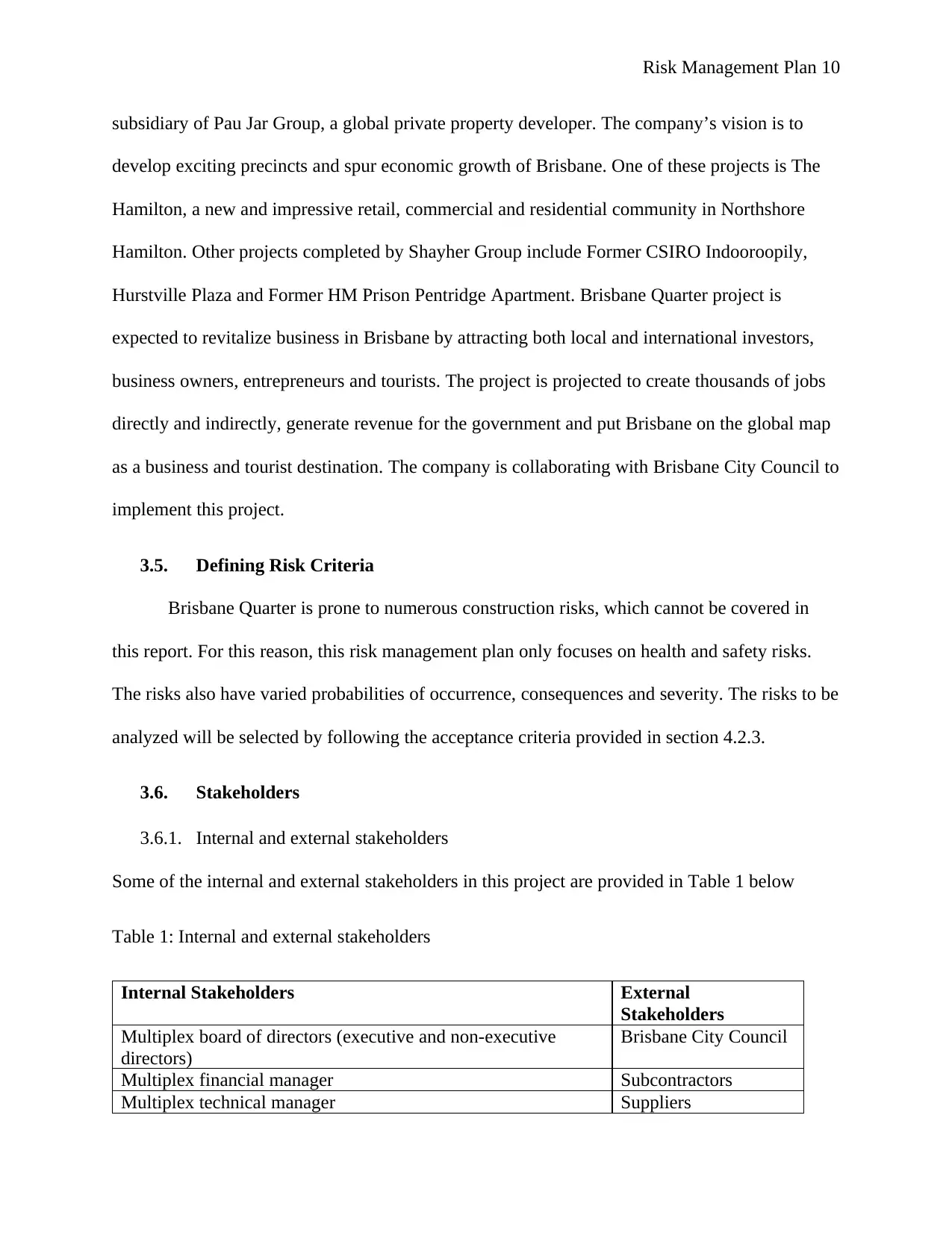
Risk Management Plan 10
subsidiary of Pau Jar Group, a global private property developer. The company’s vision is to
develop exciting precincts and spur economic growth of Brisbane. One of these projects is The
Hamilton, a new and impressive retail, commercial and residential community in Northshore
Hamilton. Other projects completed by Shayher Group include Former CSIRO Indooroopily,
Hurstville Plaza and Former HM Prison Pentridge Apartment. Brisbane Quarter project is
expected to revitalize business in Brisbane by attracting both local and international investors,
business owners, entrepreneurs and tourists. The project is projected to create thousands of jobs
directly and indirectly, generate revenue for the government and put Brisbane on the global map
as a business and tourist destination. The company is collaborating with Brisbane City Council to
implement this project.
3.5. Defining Risk Criteria
Brisbane Quarter is prone to numerous construction risks, which cannot be covered in
this report. For this reason, this risk management plan only focuses on health and safety risks.
The risks also have varied probabilities of occurrence, consequences and severity. The risks to be
analyzed will be selected by following the acceptance criteria provided in section 4.2.3.
3.6. Stakeholders
3.6.1. Internal and external stakeholders
Some of the internal and external stakeholders in this project are provided in Table 1 below
Table 1: Internal and external stakeholders
Internal Stakeholders External
Stakeholders
Multiplex board of directors (executive and non-executive
directors)
Brisbane City Council
Multiplex financial manager Subcontractors
Multiplex technical manager Suppliers
subsidiary of Pau Jar Group, a global private property developer. The company’s vision is to
develop exciting precincts and spur economic growth of Brisbane. One of these projects is The
Hamilton, a new and impressive retail, commercial and residential community in Northshore
Hamilton. Other projects completed by Shayher Group include Former CSIRO Indooroopily,
Hurstville Plaza and Former HM Prison Pentridge Apartment. Brisbane Quarter project is
expected to revitalize business in Brisbane by attracting both local and international investors,
business owners, entrepreneurs and tourists. The project is projected to create thousands of jobs
directly and indirectly, generate revenue for the government and put Brisbane on the global map
as a business and tourist destination. The company is collaborating with Brisbane City Council to
implement this project.
3.5. Defining Risk Criteria
Brisbane Quarter is prone to numerous construction risks, which cannot be covered in
this report. For this reason, this risk management plan only focuses on health and safety risks.
The risks also have varied probabilities of occurrence, consequences and severity. The risks to be
analyzed will be selected by following the acceptance criteria provided in section 4.2.3.
3.6. Stakeholders
3.6.1. Internal and external stakeholders
Some of the internal and external stakeholders in this project are provided in Table 1 below
Table 1: Internal and external stakeholders
Internal Stakeholders External
Stakeholders
Multiplex board of directors (executive and non-executive
directors)
Brisbane City Council
Multiplex financial manager Subcontractors
Multiplex technical manager Suppliers
Paraphrase This Document
Need a fresh take? Get an instant paraphrase of this document with our AI Paraphraser
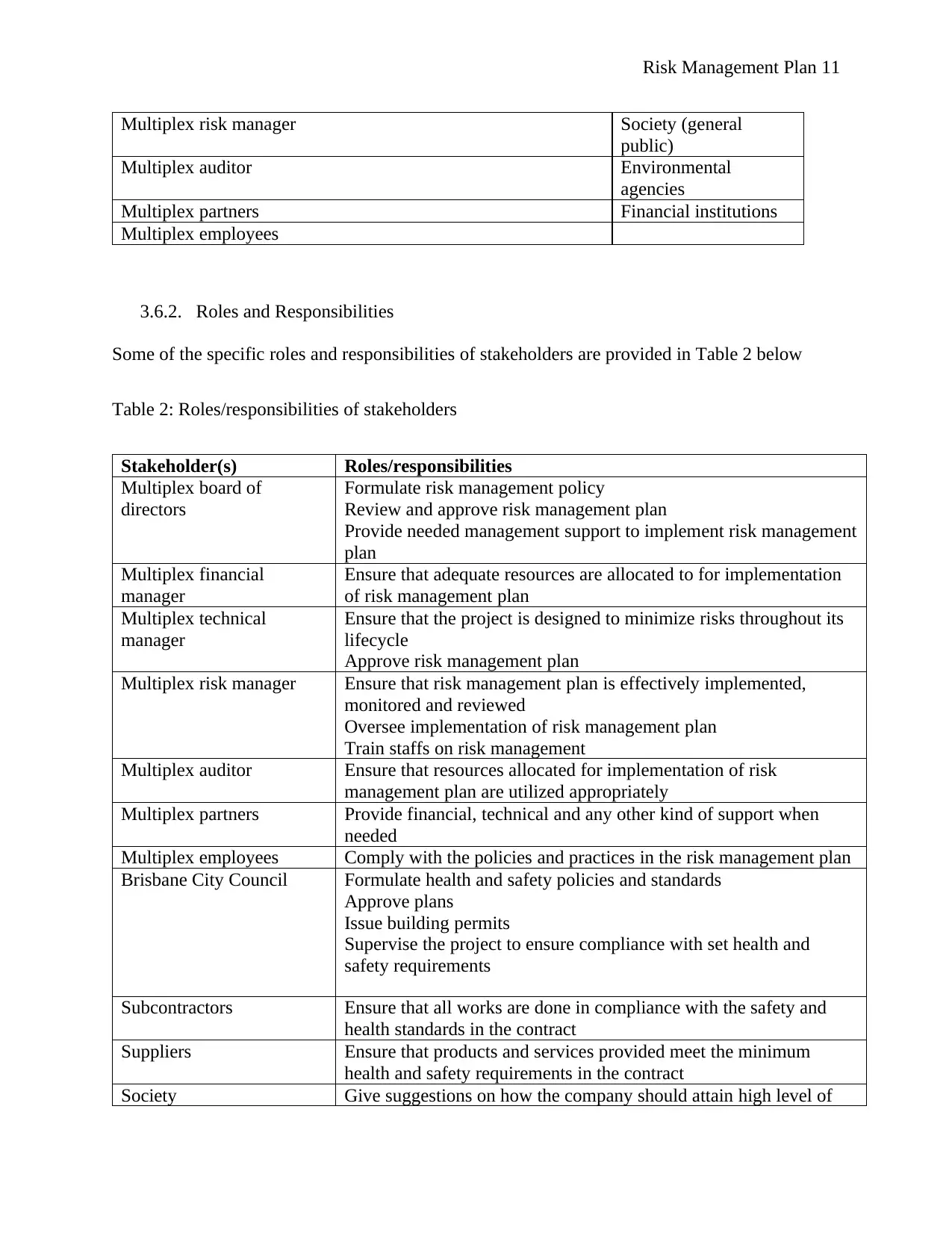
Risk Management Plan 11
Multiplex risk manager Society (general
public)
Multiplex auditor Environmental
agencies
Multiplex partners Financial institutions
Multiplex employees
3.6.2. Roles and Responsibilities
Some of the specific roles and responsibilities of stakeholders are provided in Table 2 below
Table 2: Roles/responsibilities of stakeholders
Stakeholder(s) Roles/responsibilities
Multiplex board of
directors
Formulate risk management policy
Review and approve risk management plan
Provide needed management support to implement risk management
plan
Multiplex financial
manager
Ensure that adequate resources are allocated to for implementation
of risk management plan
Multiplex technical
manager
Ensure that the project is designed to minimize risks throughout its
lifecycle
Approve risk management plan
Multiplex risk manager Ensure that risk management plan is effectively implemented,
monitored and reviewed
Oversee implementation of risk management plan
Train staffs on risk management
Multiplex auditor Ensure that resources allocated for implementation of risk
management plan are utilized appropriately
Multiplex partners Provide financial, technical and any other kind of support when
needed
Multiplex employees Comply with the policies and practices in the risk management plan
Brisbane City Council Formulate health and safety policies and standards
Approve plans
Issue building permits
Supervise the project to ensure compliance with set health and
safety requirements
Subcontractors Ensure that all works are done in compliance with the safety and
health standards in the contract
Suppliers Ensure that products and services provided meet the minimum
health and safety requirements in the contract
Society Give suggestions on how the company should attain high level of
Multiplex risk manager Society (general
public)
Multiplex auditor Environmental
agencies
Multiplex partners Financial institutions
Multiplex employees
3.6.2. Roles and Responsibilities
Some of the specific roles and responsibilities of stakeholders are provided in Table 2 below
Table 2: Roles/responsibilities of stakeholders
Stakeholder(s) Roles/responsibilities
Multiplex board of
directors
Formulate risk management policy
Review and approve risk management plan
Provide needed management support to implement risk management
plan
Multiplex financial
manager
Ensure that adequate resources are allocated to for implementation
of risk management plan
Multiplex technical
manager
Ensure that the project is designed to minimize risks throughout its
lifecycle
Approve risk management plan
Multiplex risk manager Ensure that risk management plan is effectively implemented,
monitored and reviewed
Oversee implementation of risk management plan
Train staffs on risk management
Multiplex auditor Ensure that resources allocated for implementation of risk
management plan are utilized appropriately
Multiplex partners Provide financial, technical and any other kind of support when
needed
Multiplex employees Comply with the policies and practices in the risk management plan
Brisbane City Council Formulate health and safety policies and standards
Approve plans
Issue building permits
Supervise the project to ensure compliance with set health and
safety requirements
Subcontractors Ensure that all works are done in compliance with the safety and
health standards in the contract
Suppliers Ensure that products and services provided meet the minimum
health and safety requirements in the contract
Society Give suggestions on how the company should attain high level of
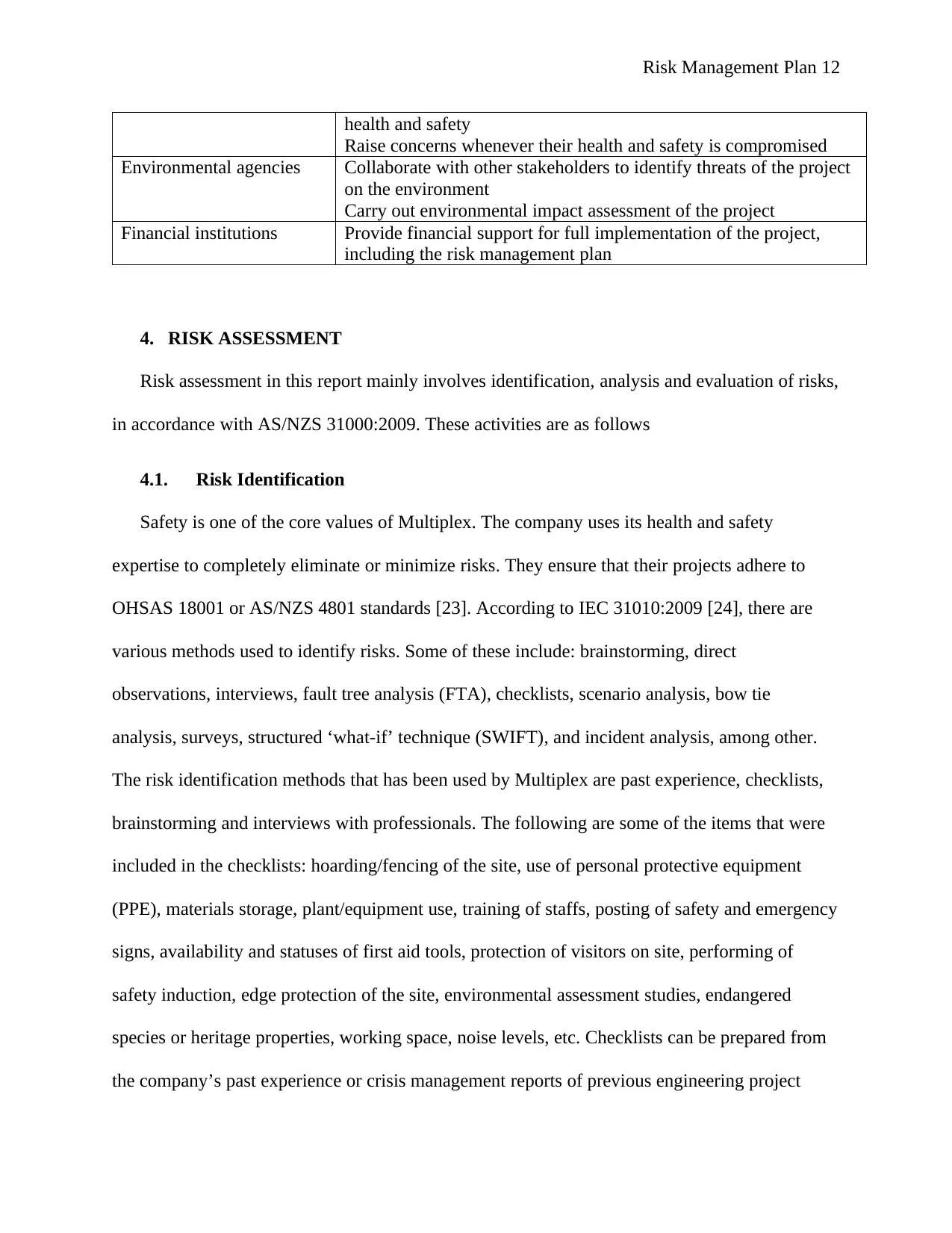
Risk Management Plan 12
health and safety
Raise concerns whenever their health and safety is compromised
Environmental agencies Collaborate with other stakeholders to identify threats of the project
on the environment
Carry out environmental impact assessment of the project
Financial institutions Provide financial support for full implementation of the project,
including the risk management plan
4. RISK ASSESSMENT
Risk assessment in this report mainly involves identification, analysis and evaluation of risks,
in accordance with AS/NZS 31000:2009. These activities are as follows
4.1. Risk Identification
Safety is one of the core values of Multiplex. The company uses its health and safety
expertise to completely eliminate or minimize risks. They ensure that their projects adhere to
OHSAS 18001 or AS/NZS 4801 standards [23]. According to IEC 31010:2009 [24], there are
various methods used to identify risks. Some of these include: brainstorming, direct
observations, interviews, fault tree analysis (FTA), checklists, scenario analysis, bow tie
analysis, surveys, structured ‘what-if’ technique (SWIFT), and incident analysis, among other.
The risk identification methods that has been used by Multiplex are past experience, checklists,
brainstorming and interviews with professionals. The following are some of the items that were
included in the checklists: hoarding/fencing of the site, use of personal protective equipment
(PPE), materials storage, plant/equipment use, training of staffs, posting of safety and emergency
signs, availability and statuses of first aid tools, protection of visitors on site, performing of
safety induction, edge protection of the site, environmental assessment studies, endangered
species or heritage properties, working space, noise levels, etc. Checklists can be prepared from
the company’s past experience or crisis management reports of previous engineering project
health and safety
Raise concerns whenever their health and safety is compromised
Environmental agencies Collaborate with other stakeholders to identify threats of the project
on the environment
Carry out environmental impact assessment of the project
Financial institutions Provide financial support for full implementation of the project,
including the risk management plan
4. RISK ASSESSMENT
Risk assessment in this report mainly involves identification, analysis and evaluation of risks,
in accordance with AS/NZS 31000:2009. These activities are as follows
4.1. Risk Identification
Safety is one of the core values of Multiplex. The company uses its health and safety
expertise to completely eliminate or minimize risks. They ensure that their projects adhere to
OHSAS 18001 or AS/NZS 4801 standards [23]. According to IEC 31010:2009 [24], there are
various methods used to identify risks. Some of these include: brainstorming, direct
observations, interviews, fault tree analysis (FTA), checklists, scenario analysis, bow tie
analysis, surveys, structured ‘what-if’ technique (SWIFT), and incident analysis, among other.
The risk identification methods that has been used by Multiplex are past experience, checklists,
brainstorming and interviews with professionals. The following are some of the items that were
included in the checklists: hoarding/fencing of the site, use of personal protective equipment
(PPE), materials storage, plant/equipment use, training of staffs, posting of safety and emergency
signs, availability and statuses of first aid tools, protection of visitors on site, performing of
safety induction, edge protection of the site, environmental assessment studies, endangered
species or heritage properties, working space, noise levels, etc. Checklists can be prepared from
the company’s past experience or crisis management reports of previous engineering project
⊘ This is a preview!⊘
Do you want full access?
Subscribe today to unlock all pages.

Trusted by 1+ million students worldwide
1 out of 23
Related Documents
Your All-in-One AI-Powered Toolkit for Academic Success.
+13062052269
info@desklib.com
Available 24*7 on WhatsApp / Email
![[object Object]](/_next/static/media/star-bottom.7253800d.svg)
Unlock your academic potential
Copyright © 2020–2026 A2Z Services. All Rights Reserved. Developed and managed by ZUCOL.





